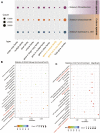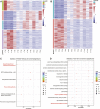Genome-wide identification analysis in wild-type Solanum pinnatisectum reveals some genes defending against Phytophthora infestans
- PMID: 38812971
- PMCID: PMC11134371
- DOI: 10.3389/fgene.2024.1379784
Genome-wide identification analysis in wild-type Solanum pinnatisectum reveals some genes defending against Phytophthora infestans
Abstract
Solanum pinnatisectum exhibits strong resistance to late blight caused by Phytophthora infestans but only an incomplete genome assembly based on short Illumina reads has been published. In this study, we generated the first chromosome-level draft genome for the wild-type potato species S. pinnatisectum in China using Oxford Nanopore technology sequencing and Hi-C technology. The high-quality assembled genome size is 664 Mb with a scaffold N50 value of 49.17 Mb, of which 65.87% was occupied by repetitive sequences, and predominant long terminal repeats (42.51% of the entire genome). The genome of S. pinnatisectum was predicted to contain 34,245 genes, of which 99.34% were functionally annotated. Moreover, 303 NBS-coding disease resistance (R) genes were predicted in the S. pinnatisectum genome to investigate the potential mechanisms of resistance to late blight disease. The high-quality chromosome-level reference genome of S. pinnatisectum is expected to provide potential valuable resources for intensively and effectively investigating molecular breeding and genetic research in the future.
Keywords: Hi-C technology; assembly; ont; potatoes; resistance gene.
Copyright © 2024 Shen, Lu, Yang, Zhang, Huang, Li, Que and Chen.
Conflict of interest statement
Authors XZ and XH are employed by Grandomics Biosciences, Wuhan, China. The remaining authors declare that the research was conducted in the absence of any commercial or financial relationships that could be construed as a potential conflict of interest.
Figures





Similar articles
-
The Histological, Effectoromic, and Transcriptomic Analyses of Solanum pinnatisectum Reveal an Upregulation of Multiple NBS-LRR Genes Suppressing Phytophthora infestans Infection.Int J Mol Sci. 2020 May 1;21(9):3211. doi: 10.3390/ijms21093211. Int J Mol Sci. 2020. PMID: 32370102 Free PMC article.
-
Genome sequence analysis provides insights on genomic variation and late blight resistance genes in potato somatic hybrid (parents and progeny).Mol Biol Rep. 2021 Jan;48(1):623-635. doi: 10.1007/s11033-020-06106-x. Epub 2021 Jan 13. Mol Biol Rep. 2021. PMID: 33442830
-
A New Resistance Gene against Potato Late Blight Originating from Solanum pinnatisectum Located on Potato Chromosome 7.Front Plant Sci. 2017 Oct 4;8:1729. doi: 10.3389/fpls.2017.01729. eCollection 2017. Front Plant Sci. 2017. PMID: 29085380 Free PMC article.
-
Improved Genome Sequence and Gene Annotation Resource for the Potato Late Blight Pathogen Phytophthora infestans.Mol Plant Microbe Interact. 2020 Aug;33(8):1025-1028. doi: 10.1094/MPMI-02-20-0023-A. Epub 2020 Jun 10. Mol Plant Microbe Interact. 2020. PMID: 32310703
-
Late blight resistance genes in potato breeding.Planta. 2022 May 16;255(6):127. doi: 10.1007/s00425-022-03910-6. Planta. 2022. PMID: 35576021 Free PMC article. Review.
References
LinkOut - more resources
Full Text Sources
Research Materials
Miscellaneous

